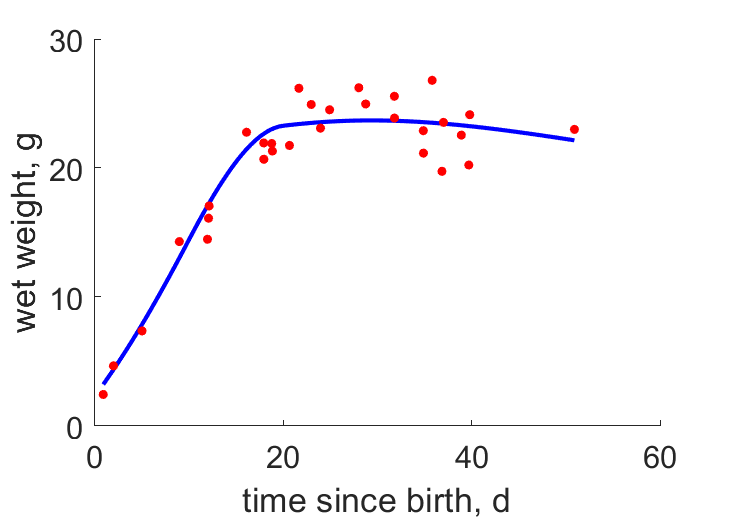Predictions & Data for this entry
| Model: std | climate: Aw | migrate: | phylum: |
| COMPLETE = 2.5 | ecozone: TN | food: biCi | class: |
| MRE = 0.018 | habitat: 0iTh, 0iTf, 0iTi, 0iTg | gender: Dg | order: |
| SMSE = 0.001 | embryo: Tncfm | reprod: O | family: |
Zero-variate data
| Data | Observed | Predicted | (RE) | Unit | Description | Reference |
|---|---|---|---|---|---|---|
| ab | 23 | 22.97 | (0.001512) | d | age at birth | avibase |
| tx | 40.5 | 40.46 | (0.0009619) | d | time since birth at fledging | avibase |
| tp | 121.5 | 122.2 | (0.005623) | d | time since birth at puberty | guess |
| tR | 365 | 365 | ( 0) | d | time since birth at 1st brood | guess |
| am | 5840 | 5821 | (0.003319) | d | life span | guess |
| Ww0 | 3 | 2.902 | (0.0327) | g | initial wet weight | MariStil1993 |
| Wwb | 2.3 | 2.325 | (0.01103) | g | wet weight at birth | MariStil1993 |
| Wwi | 108 | 107.6 | (0.003817) | g | ultimate wet weight for females | avibase |
| Ri | 0.01096 | 0.01098 | (0.00217) | #/d | maximum reprod rate | avibase |
Uni- and bivariate data
| Data | Figure | Independent variable | Dependent variable | (RE) | Reference |
|---|---|---|---|---|---|
| tW |  | time since birth | wet weight | (0.06949) | MariStil1993 |
Pseudo-data at Tref = 20°C
| Data | Generalised animal | Streptoprocne rutila | Unit | Description |
|---|---|---|---|---|
| v | 0.02 | 0.01913 | cm/d | energy conductance |
| p_M | 18 | 373 | J/d.cm^3 | vol-spec som maint |
| k_J | 0.002 | 0.01551 | 1/d | maturity maint rate coefficient |
| k | 0.3 | 0.3041 | - | maintenance ratio |
| kap | 0.8 | 0.9807 | - | allocation fraction to soma |
| kap_G | 0.8 | 0.8007 | - | growth efficiency |
| kap_R | 0.95 | 0.95 | - | reproduction efficiency |
Discussion
- Feeding is reduced just before fledge
- Males are assumed not to differ from females
- mod_1: Pseudo-data point k is used, rather than k_J; Data set tp and parameter t_R are added, the latter replacing clutch interval t_N. Postnatal T is based on PrinPres1991, see get_T_Aves. See further the revision page, theme puberty
Bibliography